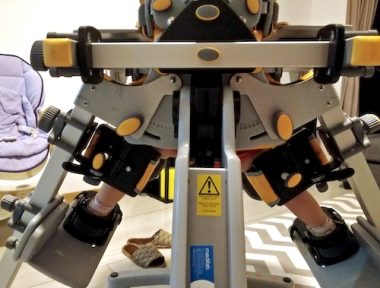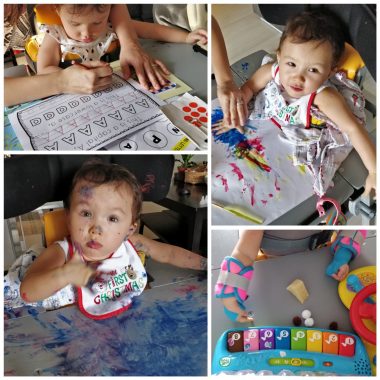Standing Tall With AADC
Written by |

Courtesy of Richard E. Poulin III
Rylae-Ann learns and receives physical therapy in her stander.
When I first learned about the severe symptoms associated with aromatic l-amino acid decarboxylase (AADC) deficiency, standing seemed like an impossibility for my now 3-year-old daughter, Rylae-Ann. However, physical therapists told me about a device that makes standing possible while serving as a form of therapy.
At the time she was diagnosed, there was little information about AADC children using standers or support in general. However, in looking at other communities for children with physical challenges, we found that standers were frequently discussed, and could also benefit those with AADC. We sought guidance from a physical therapist, and other caregivers shared information.
Standers, also known as standing frames, scaffold children with physical disabilities by supporting them as they learn how to stand. The stander can improve their quality of life, help integrate them into the classroom, and provide more access to activities. Depending on the type of stander, it can easily be adapted to each child’s individual needs. As they grow and improve, you can adjust it, making it an excellent long-term device.
My experience
When my daughter was ready, we purchased an adaptive stander that could be used for several years. This made looking at the bill easier.
Initially, Rylae was scared of the device, as she is with anything new. For the first few days, we simply let her see and touch it. Then, we slowly put her in when she was in a happy mood. While I strapped her in, my wife kept her occupied with her favorite song. Success! She was in and not screaming.

We sent photos to our physical therapist for input. (Courtesy of Richard E. Poulin III)
Slowly, we began to make the stander upright, to the degree our physical therapist advised. This allowed Rylae to bear some weight while upright, but not enough to cause discomfort. She had a desk in front of her so she could play with her toys or watch her iPad. Usually, one of us was playing or interacting with her. Over time, she became more comfortable with the device and could play independently, which freed us up to do our household chores.
As Rylae learned the routine and schedule associated with the stander, it became easier to put her in it. We began to do more activities in the stander, and saw progress over time. Our device was waterproof, so we could do sensory activities with water and paints. We could easily clean the desk extension and parts. The stander allowed us to work on standing while also focusing on sensory integration and fine motor skills.

Rylae-Ann uses the stander to play and learn. (Courtesy of Richard E. Poulin III)
One important piece of advice our doctor shared was to never feed her in the stander. Feeding can be troublesome for AADC babies, but the stander should never be used as a feeding chair due to the number of straps required to support the child. If there were ever any trouble while eating, you would need to undo everything quickly.
Given the hefty price tag, and many other pressing issues like ICU bills and surgery, we delayed purchasing a stander. I wished we would have started sooner, as keeping children in a seated or supine position can lead to sore spots, pain, and skeletal deformities. As parents and caregivers, we need to be aware of this, and standers are a fantastic option with many benefits.
Alternatives to standers
Investing in a stander is costly, especially one with all the extra features we want so badly for our children. However, if you’re considering a stander, know there are more affordable options. With guidance from a licensed physical therapist, you can learn how to perform physical therapy at home.
Using your body as support is free, and helps to put your child in an upright position. The negative is that your hands will be busy assisting your little one, so you will need someone to interact with them or be a spotter while you work. Another negative is that it is not as easy to adjust how much weight-bearing they do. You can let them lean on you, but some balancing and practice are required.

Use your body and sofa as a way to support standing. (Courtesy of Richard E. Poulin III)
Leg gaiters are also an option. You may hear these referred to as fabric leg braces, leg supports, or leg immobilizers. This device acts as a rigid exoskeleton, providing support to keep a child’s legs in the proper position. However, you will need to help apply the appropriate amount of weight by lifting or placing them between your legs. You can also use blocks or your body to support them. We tried this option before buying a stander, but it takes a lot of practice. Even after purchasing the stander, we used leg gaiters in conjunction with the stander during floor time.

Leg gaiters with support are a cheap alternative to standers. (Courtesy of Richard E. Poulin III)
If you have a child with AADC, what therapies have you tried to help them stand? Please share your thoughts in the comments below.
***
Note: AADC News is strictly a news and information website about the disease. It does not provide medical advice, diagnosis, or treatment. This content is not intended to be a substitute for professional medical advice, diagnosis, or treatment. Always seek the advice of your physician or other qualified health provider with any questions you may have regarding a medical condition. Never disregard professional medical advice or delay in seeking it because of something you have read on this website. The opinions expressed in this column are not those of AADC News or its parent company, Bionews, and are intended to spark discussion about issues pertaining to aromatic l-amino acid decarboxylase deficiency.






Leave a comment
Fill in the required fields to post. Your email address will not be published.